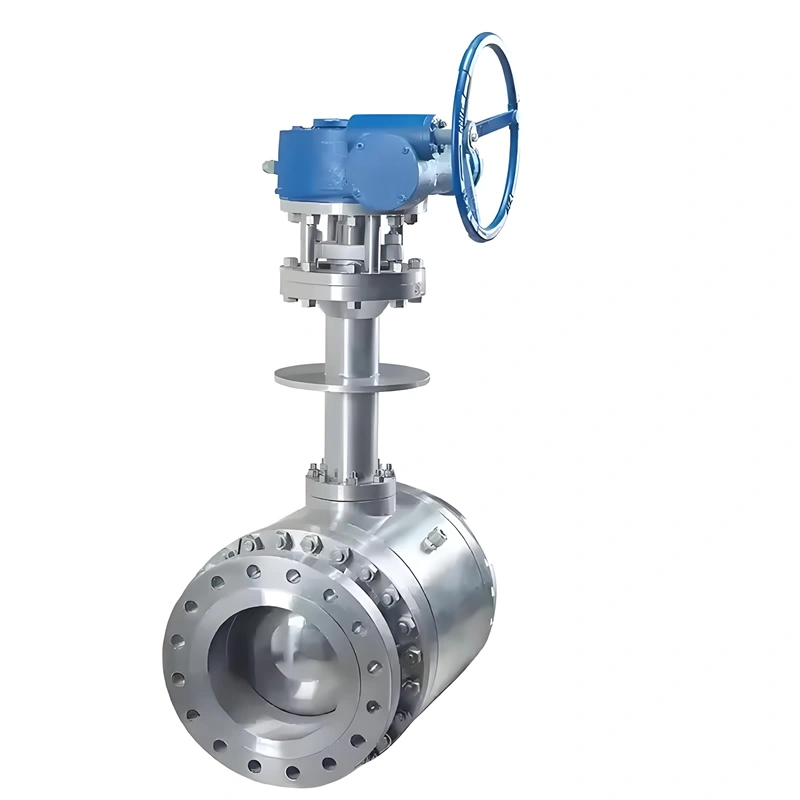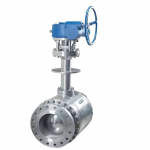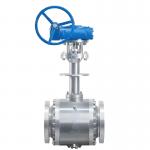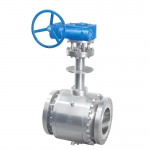Specification
API DN300 Class 300 F316 Metal Seal Manual Three-Piece Cryogenics Temperature Trunnion Mounted Ball Valve
I. Product Overview
II. Key Attribute Parameters
- Size: DN300 (12″), optimized for large-diameter cryogenic pipelines requiring high flow capacity and robust pressure handling.
- Pressure Rating: Class 300 (5.0MPa), engineered to withstand high pressure in systems like LNG transfer lines and high-pressure cryogenic storage loops.
- Temperature Range: -196℃ ~ 150℃, validated for stable operation in extreme cryogenic conditions (liquid nitrogen, LNG) to moderate high temperatures (heated gases).
- Material Configuration:
- Body & Bonnet: F316 stainless steel (ASTM A182), a molybdenum-alloyed grade (Cr16-18%, Ni10-14%, Mo2-3%) resisting corrosion from chlorides, acids, and cryogenic media.
- Ball & Trunnions: F316 with Stellite coating (hardness 55-60HRC), enhancing wear resistance and low-temperature toughness.
- Seal: Metal-to-metal hard seal with cryogenic alloy coating, maintaining elasticity at -196℃ to prevent leakage.
- Stem: F316 with anti-blowout design, ensuring safety under high pressure and resisting cold-induced brittleness.
- Connection Type: Flanged (RF/RTJ per ASME B16.5), enabling leak-tight integration with cryogenic pipeline flanges.
- Actuation: Manual (handwheel with gearbox), reducing operating torque for smooth 90° rotation in large-diameter valves.
- Design Standards: API 6D, API 608, ISO 17292, ensuring compliance with global pipeline and cryogenic valve specifications.
Product Overview
III. Features Description
- Three-Piece Structure: The valve body is divided into three detachable sections (two end caps + middle section), allowing in-line maintenance of internal components (ball, seats, stem) without removing the valve from the pipeline. This reduces downtime in critical systems like LNG transfer lines, where shutdowns are costly.
- Trunnion Mounted Ball: The ball is supported by upper and lower trunnions, distributing pressure evenly to prevent seat extrusion under Class 300 pressure. This design eliminates “ball floating”—a common issue in high-differential-pressure systems—ensuring stable sealing even with fluctuating cryogenic media flow.
- Cryogenic Metal Seal: The metal-to-metal seal is coated with a low-temperature alloy (e.g., nickel-chromium-molybdenum) to retain elasticity at -196℃, avoiding brittleness that causes leakage in standard metal seals. Precision lapping (Ra ≤0.4μm) ensures uniform contact, achieving ANSI/FCI Class VI leakage (near-zero) in cryogenic service.
- F316 Corrosion Resistance: Molybdenum in F316 resists pitting and crevice corrosion from seawater (offshore LNG terminals) and acidic cryogens (e.g., liquid CO₂), eliminating rust-related failures and extending service life in harsh environments.
- Manual Gear Actuation: The gearbox reduces operating torque by 50%, enabling one-person operation of 12″ valves. A position indicator provides clear open/close feedback, critical for precise control in LNG loading/unloading operations.
IV. Manufacturing Processes
- Material Validation: F316 forgings undergo ultrasonic testing to detect internal defects. Charpy impact tests at -196℃ verify toughness (≥27J), ensuring resistance to cold-induced fracture. Spectral analysis confirms alloy composition to guarantee corrosion resistance.
- Three-Piece Machining: CNC lathes precision-machine body sections to tight tolerances (±0.05mm), ensuring seamless alignment when bolted. Flange faces are finished per ASME B16.5 to ensure leak-tight gasket sealing.
- Trunnion & Ball Finishing: Trunnions are ground to concentricity with the ball (±0.02mm) to minimize friction. The ball’s sealing surface is lapped with the seat under cryogenic conditions (-196℃) to simulate real-world operation, ensuring uniform contact at extreme cold.
- Seal Coating Application: The metal seal is plasma-sprayed with cryogenic alloy (100-150μm thickness), then polished to Ra ≤0.8μm to enhance sealing efficiency. This coating retains flexibility at -196℃, preventing cracking during thermal cycling.
- Testing:
- Hydrostatic Test: Body tested at 1.5×Class 300 (7.5MPa) for 30 minutes; seats tested at 1.1×Class 300 (5.5MPa) with water.
- Cryogenic Immersion Test: Valve submerged in liquid nitrogen (-196℃) for 2 hours, then operated to confirm seal integrity and smooth rotation.
- Leakage Test: Helium leak detection at -196℃ verifies rate ≤1×10⁻⁹ Pa·m³/s, meeting cryogenic safety standards.
Valve Details
V. Product Advantages
- Extreme Cryogenic Reliability: Operates at -196℃ without brittleness, outperforming standard stainless steel valves in LNG, liquid nitrogen, and liquid oxygen systems.
- In-Line Maintenance: Three-piece design allows component replacement without pipeline removal, reducing downtime by 60% compared to one-piece valves in critical cryogenic loops.
- High-Pressure Stability: Trunnion mounting prevents seat extrusion under Class 300 pressure, ensuring consistent sealing in fluctuating flow environments (e.g., LNG tank filling).
- Corrosion Resistance: F316 with molybdenum resists harsh media, extending service life by 30% in coastal or chemical cryogenic applications.
- API Compliance: Meets API 6D/608 standards, including fire-safe performance (API 6FA), ensuring compatibility with global oil & gas and cryogenic projects.
Application
VI. Application Fields
- LNG Infrastructure: Controls LNG transfer between storage tanks, trucks, and ships, withstanding -162℃ (LNG boiling point) and high transfer pressures.
- Cryogenic Processing: Regulates liquid nitrogen, oxygen, and argon in medical, metallurgical, and food freezing systems, ensuring precise flow control at extreme cold.
- Chemical Industry: Manages low-temperature reactants (e.g., liquid CO₂, refrigerants) in pharmaceutical and specialty chemical production, leveraging F316’s corrosion resistance.
- Natural Gas Processing: Handles cryogenically cooled natural gas in fractionation plants, where high pressure and low temperatures require robust sealing.
- Energy Sector: Used in LNG-fired power plants to control fuel flow from storage to combustion systems, withstanding temperature swings from -162℃ to 150℃.
RELATED
-

High Temperature/Pressure 304 Stainless Steel Resistant Manual Power Forged Three Piece Flanged Floating Ball Valve
TIANYU 304 Stainless Steel Flanged Floating Ball Valve: Corrosion-Resistant Full-Port Flow Control Solution for Industrial, Sanitary, and Municipal Me…
BALL VALVE 11/03/2025 -

API ANSI 2in-16in DN50-DN400 PN10 PN16 CF8M Pneumatic Flanged Floating Ball Valve
TIANYU CF8M Pneumatic Flanged Floating Ball Valve: 2in-16in (DN50-DN400) PN10-PN16 API/ANSI Class Corrosion-Resistant Flow Control Solution for Indust…
BALL VALVE 11/01/2025 -

Large-Diameter DN1400 CLASS150 WCB SS Triple Eccentric Metal-Sealed Hard Seal Butterfly Valve
TIANYU DN1400 (56″) CLASS 150 WCB Hard Seal Butterfly Valve: Triple Eccentric Metal-Sealed Flanged Valve for Large-Diameter Industrial Media wit…
BUTTERFLY VALVE 10/30/2025 -

PN16 Stainless Steel Floating Ball Valve: Full Port 2PC Flange-Connected Valve with Fire-Safe & Anti-Static SS Ball Valve
TIANYU Stainless Steel Floating Ball Valve: Full Port 2PC Flange-Connected Valve with Fire-Safe & Anti-Static Design for Oil, Gas, and Industrial …
BALL VALVE 10/29/2025 -

High-Performance DN80 Class 150 WCB Soft-Sealed Lug-Type Double Eccentric Butterfly Valve
TIANYU 3” Class 150 WCB lug-type double eccentric butterfly valve is a technologically advanced flow control device engineered to address the challeng…
BUTTERFLY VALVE 10/25/2025 -

DN125 PN16 CF8M Stainless Steel Lug-Type Butterfly Valve with PTFE Lining Concentric Line Butterfly Valves
TIANYU DN125 PN16 CF8M stainless steel lug-type butterfly valve is a precision-engineered flow control device designed to address the challenges of ha…
BUTTERFLY VALVE 10/25/2025





